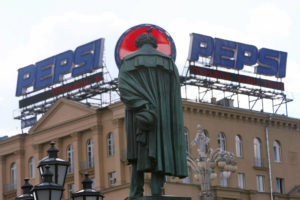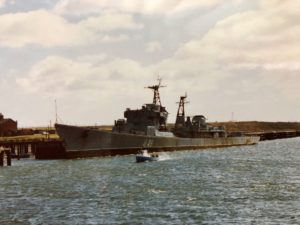Jul
4
When Pepsi Had a Navy
“We’re disarming the Soviet Union faster than you are.” — Donald M. Kendall, CEO of Pepsi, to Brent Scowcroft, President George H.W. Bush’s national security adviser

It was 1990, and the Cold War was coming to an end, as the Soviet Union dissolved from within. Odd as it may sound, Pepsi “suddenly” found itself in possession of a veritable fleet of former Soviet Naval vessels. (Well, OK, most of it was rusted-out hulks built in the 1950s.) The reason for this can be traced back to a Vice President of the United States and a forward-thinking Pepsi executive who took a big risk 30 years earlier.
Developing from the 1958 U.S.–Soviet Cultural Agreement, the two superpowers agreed to hold exhibits in each other’s countries the following year as a cultural exchange “to promote understanding.” During the opening of the American National Exhibition in Moscow in July 1959, an impromptu exchange occurred between Soviet First Secretary Nikita Khrushchev and U.S. Vice President Richard Nixon. (This was later dubbed the Kitchen Debate, because the primary location of the exchange was in the kitchen of a model, suburban American home.) One of the 450+ American companies displaying their goods at the exhibit was Pepsi-Cola, and Donald M. Kendall, head of Pepsi’s international division, saw a great opportunity. He had earlier persuaded Nixon to maneuver Khrushchev over to the Pepsi display, where they would imbibe Pepsi made from American and Russian water, respectively. Nixon came through.
Khrushchev liked the product and was instrumental in getting Pepsi a foothold in the Soviet Union. The New York Times touted it as “the first capitalistic product” available in the USSR. The problem, however, was money. The Soviet ruble was worthless outside the Motherland, and Soviet law wouldn’t allow its use, anyway. So, they came up with a trade — Pepsi’s syrup (to be mixed and bottled locally) in exchange for Stolichnaya vodka (to sell in the U.S.). Meanwhile, Kendall rose quickly through the ranks and became CEO in 1965. In 1972, Pepsi negotiated an exclusive deal that locked Coca-Cola out of the USSR until 1985.
By the late-1980s, Russians were watching Michael Jackson hawk Pepsi on TV and were drinking approximately a billion servings of Pepsi per year. Problems arose, however, when Americans began boycotting Russian products due to objections over the Soviet-Afghan War. If Pepsi couldn’t sell the vodka, they needed something else of value to receive in trade.

“[I]n the spring of 1989, Pepsi and the Soviet Union signed a remarkable deal. Pepsi became the middleman for 17 old submarines and three warships, including a frigate, a cruiser, and a destroyer, which the company sold for scrap. Pepsi also bought new Soviet oil tankers and leased them out or sold them in partnership with a Norwegian company. In return, the company could more than double the number of Pepsi plants in the Soviet Union.”
On April 9, 1990, American newspapers reported an even bigger, three billion dollar agreement between Pepsi and the USSR. (The amount was based on sales estimates for cola and vodka over the next 10 years.) As payment, Pepsi got another 10 Soviet ships. They were also able to spread the Pizza Hut franchise into Russia.
Unfortunately, the fall of the Soviet Union in 1991 blew most of those plans out of the water. Suppliers in the formerly Soviet states were no longer beholden to old contracts, and some demanded better arrangements. Pepsi had to renegotiate deals with 15 newly-independent countries, plus they now had to deal with aggressive moves by their #1 competitor, Coca-Cola. This was when Pepsi put up two iconic billboards over Pushkin Square in Moscow. Pepsi never quite regained their marketing advantage, the novelty-effect now working for other brands. Coke eventually became Russia’s most popular cola, and the billboards over Pushkin Square were removed in 2013. On the plus side, Russia is still Pepsi’s second biggest market outside the U.S.
Also, I’m guessing Pepsi no longer has to deal with old Soviet warships as payment. Not sure about the vodka…















